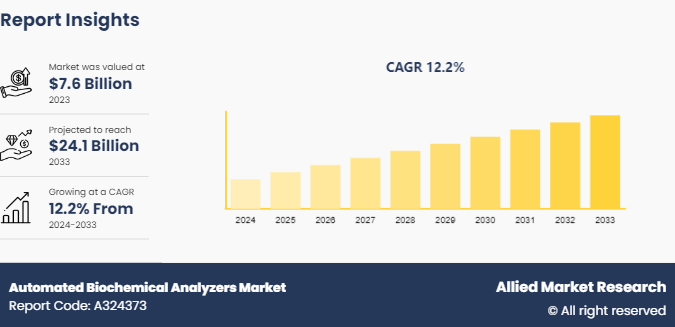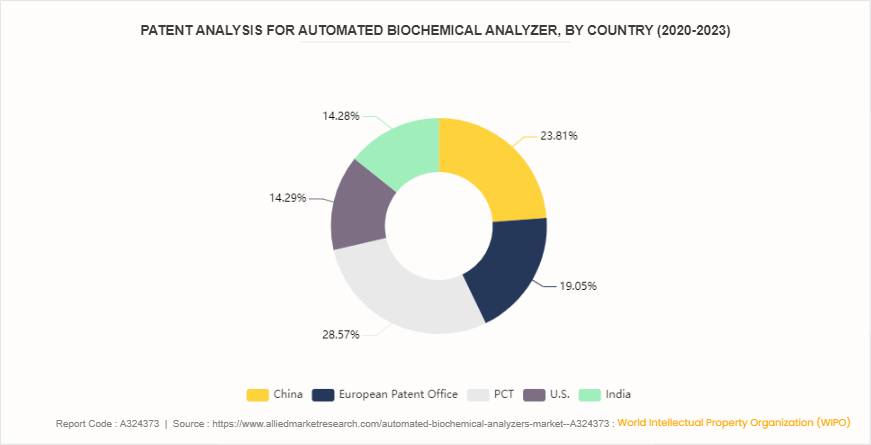Automated Biochemical Analyzers Market Research, 2033
The global automated biochemical analyzers market size was valued at $7.6 billion in 2023, and is projected to reach $24.1 billion by 2033, growing at a CAGR of 12.2% from 2024 to 2033. The increasing demand for efficient and high-throughput diagnostic testing, advancements in automation technology improving accuracy and speed, and the rising prevalence of chronic diseases requiring frequent biochemical analysis are the major factors which drives the market growth.

Market Introduction and Definition
Automated biochemical analyzers are advanced laboratory instruments designed to perform biochemical tests on biological samples with minimal human intervention. These analyzers automate processes such as sample handling, mixing, incubation, and measurement of biochemical reactions. They utilize technologies such as spectrophotometry and immunoassays to quantitatively analyze biomarkers such as enzymes, metabolites, and proteins. These systems enhance efficiency by reducing manual errors, increasing throughput, and providing accurate and reproducible results crucial for medical diagnostics, research, and quality control in various industries including healthcare and pharmaceuticals.
Key Takeaways
The automated biochemical analyzers market share study covers 20 countries. The research includes a segment analysis of each country in terms of value for the projected period.
More than 1, 500 product literatures, industry releases, annual reports, and other such documents of major automated biochemical analyzers industry participants along with authentic industry journals, trade associations' releases, and government websites have been reviewed for generating high-value industry insights.
The study integrated high-quality data, professional opinions and analysis, and critical independent perspectives. The research approach is intended to provide a balanced view of global markets and to assist stakeholders in making educated decisions in order to achieve their most ambitious growth objectives.
Key Market Dynamics
The rise in prevalence of chronic diseases such as diabetes, cardiovascular diseases, and cancer is a significant driver for the automated biochemical analyzers market growth. These conditions require regular monitoring and biochemical analysis for effective management. For instance, diabetic patients need frequent blood glucose testing, while cardiovascular patients require lipid profile assessments. Automated biochemical analyzers facilitate these routine tests by providing rapid, accurate, and reliable results, essential for timely diagnosis and treatment. Rise in prevalence of chronic diseases led to rise in demand for efficient diagnostic tools such as automated analyzers.
In addition, rise in technological advancements are a major drives the automated biochemical analyzers market size. Innovations in automation, robotics, and artificial intelligence have significantly improved the functionality and efficiency of these analyzers. Modern analyzers offer higher throughput, enhanced accuracy, and faster turnaround times. Features such as automated sample handling, barcode labeling, and integrated software systems for data management streamline laboratory workflows, reduce human errors, and enhance overall productivity. The integration of advanced detection methods, including chemiluminescence and mass spectrometry, expands the range of detectable analytes, further driving growth during automated biochemical analyzers market forecast period.
Furthermore, the geriatric population is more susceptible to various health conditions that require frequent biochemical testing for effective management which propels market growth. Age-related diseases such as osteoporosis, Alzheimer's, and other metabolic disorders necessitate regular monitoring through biochemical assays thereby driving the demand for automated biochemical analyzers.
However, the high initial costs associated with purchasing and installing advanced automated analyzers can be a significant barrier, particularly for smaller healthcare facilities and laboratories with limited budgets which may limit market growth. On the other hand, expanding applications of analyzers in veterinary diagnostics, and the integration of AI and machine learning technologies provides an automated biochemical analyzers market opportunity.
Patent Analysis for Automated Biochemical Analyzers System, by Country (2020-2023)
The patent analysis by the World Intellectual Property Organization (WIPO) highlights significant trends in automated biochemical analyzer innovation across key regions. China leads with 23.8% of total patents, emphasizing its role as a major contributor to technological advancements in the field. The European Patent Office and the PCT (Patent Cooperation Treaty) collectively account for 47.6% of patents, reflecting strong innovation efforts across Europe and globally. The U.S. and India each contribute 14.3%, showcasing their growing capabilities and investments in automated analyzer technologies. These patent figures indicate a competitive landscape driven by continuous research and development aimed at enhancing the functionality, efficiency, and reliability of automated biochemical analyzers. The concentration of patents in these regions also signifies strategic advantages in market competitiveness, influencing the growth trajectory of the automated biochemical analyzer market, driving technological advancements, and expanding applications across diverse healthcare and research domains.

Market Segmentation
The automated biochemical analyzers market analysis is segmented into analyzer, application, end user, and region. On the basis of the analyzer, the market is segmented into biochemistry analyzers, immuno-based analyzers, and hematology analyzers. By application, the market is classified into drug discovery, genomics, proteomics, bioanalysis, analytical chemistry, and others. By end user, the market is divided into diagnostic laboratories, pharmaceutical and biotechnology companies, and others. Region wise, it is analyzed across North America, Europe, Asia-Pacific, and LAMEA.
Regional/Country Market Outlook
North America leads with a significant automated biochemical analyzers market share, driven by advanced healthcare infrastructure, high healthcare expenditure, and technological innovations. In addition, increasing prevalence of chronic diseases and a strong emphasis on early disease detection drives the market growth in this growth. However, Asia-Pacific emerges as a rapidly growing market fueled by expanding healthcare infrastructure, growing investments in healthcare, and increasing awareness about advanced diagnostic technologies. LAMEA is also witnessing growth, supported by improving healthcare access and infrastructure development initiatives.
According to American Medical Association, the health spending in the U.S. increased by 4.1% in 2022 ($4.4 trillion) . This higher expenditure supports the adoption of advanced medical technologies, including automated analyzers, across hospitals, clinics, and diagnostic laboratories in the North America region.
Industry Trends
The government of Nepal received a donation of fully automated biochemistry analyzers worth $402, 500 from the Embassy of the Republic of Korea in 2023. This initiative aims to support Nepal's healthcare system by providing advanced diagnostic equipment. Thus, this initiative is poised to drive growth in the automated biochemistry analyzers market.
As per an article published by National Center for Biotechnology and Information (NCBI) in 2023, the analytical performance of the 21 biochemical analytes was tested on two automated analyzers, Cobas 6000 and C311 analyzers which plays a crucial role in driving growth in the automated biochemistry analyzers market.
Competitive Landscape
The major players operating in the automated biochemical analyzers market include Thermo Fisher Scientific, Danaher Corporation, Hudson Robotics Inc., Becton Dickinson and Company, Synchron Lab Automation, Agilent Technologies Inc., Siemens, Tecan Group Ltd, PerkinElmer Inc., and Honeywell International Inc.
Recent Key Strategies and Developments in Automated Biochemical Analyzers Industry
In January 2024, Beckman Coulter Diagnostics, a clinical diagnostics leader, launched its new DxC 500 AU Chemistry Analyzer, an automated clinical chemistry analyzer, at Medlab Middle East in Dubai. The DxC 500 AU Chemistry Analyzer is one of several recent Beckman Coulter solutions designed to address the complete needs of healthcare systems that are looking to complement central hub laboratories by advancing the technology and capabilities of satellite and independent hospital laboratories.
In July 2023, Beckman Coulter Diagnostics, a clinical diagnostics leader, received FDA clearance for its new DxC 500 AU Chemistry Analyzer, an automated chemistry analyzer, expanding the company’s clinical chemistry offering and demonstrating ongoing commitment to product innovation in the in vitro diagnostic industry. Designed for small-to-medium-sized laboratories, the DxC 500 AU Chemistry Analyzer is one of several recent Beckman Coulter solutions designed to optimize laboratory workflows and support critical clinical decisions.
Key Benefits For Stakeholders
- This report provides a quantitative analysis of the market segments, current trends, estimations, and dynamics of the automated biochemical analyzers market analysis from 2024 to 2033 to identify the prevailing automated biochemical analyzers market opportunities.
- The market research is offered along with information related to key drivers, restraints, and opportunities.
- Porter's five forces analysis highlights the potency of buyers and suppliers to enable stakeholders make profit-oriented business decisions and strengthen their supplier-buyer network.
- In-depth analysis of the automated biochemical analyzers market segmentation assists to determine the prevailing market opportunities.
- Major countries in each region are mapped according to their revenue contribution to the global market.
- Market player positioning facilitates benchmarking and provides a clear understanding of the present position of the market players.
- The report includes the analysis of the regional as well as global automated biochemical analyzers market trends, key players, market segments, application areas, and market growth strategies.
Automated Biochemical Analyzers Market , by Analyzer Report Highlights
| Aspects | Details |
| Market Size By 2033 | USD 24.1 Billion |
| Growth Rate | CAGR of 12.2% |
| Forecast period | 2024 - 2033 |
| Report Pages | 228 |
| By Analyzer |
|
| By Application |
|
| By End User |
|
| By Region |
|
| Key Market Players | Tecan Group Ltd, Thermo Fisher Scientific Inc., Siemens, Synchron Lab Automation, Honeywell International Inc., Danaher Corporation, Agilent Technologies Inc., Becton Dickinson and Company, Hudson Robotics Inc., PerkinElmer Inc. |
The total market value of automated biochemical analyzers market is $7.6 billion in 2023.
The market value of automated biochemical analyzers market in 2033 is $24.1 billion.
The forecast period for automated biochemical analyzers market is 2024 to 2033.
Growth drivers include technological advancements in automation, rising demand for high-throughput diagnostic testing, increasing prevalence of chronic diseases, and expanding healthcare infrastructure.
Automated biochemical analyzers are laboratory instruments designed to perform biochemical tests with minimal manual intervention, enhancing testing efficiency and accuracy.
Loading Table Of Content...


